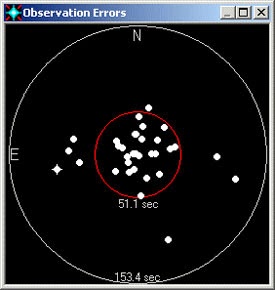Increase resolution - How to find the FOV for the camera/scope combo
The first is to use a CCD
chip with smaller pixels. The problem here is that you are limited by
what cameras are available and by financial considerations. Also, to get
a wide field of view with small pixels you need a CCD with a large number of
pixels. This means more money and more data for the computer to deal
with, making for more processor-intensive image manipulation.
So, more pixels and small,
but hold a minute apart from the cost there is other issues.
Relatively inexpensive
CCDs typically have smaller chips, can have a
lower quantum efficiency,
and lack certain features such as self-guiding and compatibility with certain
accessories. Advanced CCDs take up where the smaller camera leave off,
offering larger chips and more.
If the goal of your
imaging is to get pretty pictures, the number of pixels on the CCD chip can be
an important factor. More
pixels means a larger image on screen and the possibility of creating
larger prints. Cameras with a large number of pixels will often have
small pixel sizes, meaning the
resolution is higher than a chip with large pixels, which is also often
an advantage.
The advantage of larger
pixels is increased sensitivity and a better match to longer focal length
telescopes.
On short focal length scopes, large pixels can produce undersampled images where the
resolution is not as high as is possible. While the disadvantage to small pixels on a long focal length scope is a decrease in sensitivity, this is more than made up for by
the advantages that the sheer number of pixels provides for image processing
and display.
For example. is the
11-million-pixel STL-11000M camera from SBIG. This camera offers a huge
field of view and tons of pixels for extremely high-resolution images
For a basic rule of thumb,
§
figure you
want small pixels (13-microns or less or 0.013mm) for short-focal-length
telescopes, and,
§
larger pixels
(16-microns and up) for very long-focal-length scopes.
But for pretty pictures,
the rules can pretty easily be stretched. If your goal is achieving the
best resolution of reaching the faintest possible magnitudes, sampling is more
critical.
The only way to get more up
close and personal is to increase the resolution of the image. The small chip
gives the impression of being really zoomed in, but this is not the case. An
object of size 30"x30" will always span 30x30 pixels at 1"/pix
for all chips, from the webcam type to the KAI 11MP.
The properties that define the resolution are...pixel size and focal length. The relation here is for pixel size in microns (micrometers) and focal length in mm.
arcsec/pix= pixel size/focal length * 206
The properties that define the resolution are...pixel size and focal length. The relation here is for pixel size in microns (micrometers) and focal length in mm.
arcsec/pix= pixel size/focal length * 206
For a Sony ICX285 type chip found in the Atik16HR, QHY??? and SXV H9 the
pixel size is 6.45um (microns), and asuming a focal length of 780mm, this
corresponds to 1.73"/pix.
Arcsec/pixels =(6.45 /780)*206 = 1.7”/pix
To find the FOV for the camera/scope combo,
Multiply this by the number of pixels in the horizontal and vertical
directions. For the case of the ICX285 (1392X1040), the field of view is
40'X30'.
FOV = 1.7 x (1392 x 1040) = 1.7 x
1392/60 = 39.44
= 1.7 x 1040/60 = 29.47
FOV = 40’x30’
The
ICX285 type is a good chip...very sensitive and has low dark current.
answer to the framing of M51 angular diameter is 11x7 arc-minutes...therefore the camera FOV with the telescope 780mm long will produce a 40’ x 30’ which is well over the M51 diameter.
answer to the framing of M51 angular diameter is 11x7 arc-minutes...therefore the camera FOV with the telescope 780mm long will produce a 40’ x 30’ which is well over the M51 diameter.
If this is too small a sensor, you could try the KAI 4021/4022 sensor. Due to its design it has a lower sensitivity and higher dark current. it has 7.4um pixels and a 2048x2048 sensor. Starlight express use this chip in the H16 camera.
Or if you are feeling wealthy, the KAF3200ME is incredibly sensitive...around 0.75 at Ha (656nm). it is a 3.2MP sensor with 6.8um pixels. However, it doesnt feature an antiblooming structure so bright stars will bloom during an exposure.
A camera can have an arbritary size of pixel (almost) usually from 5-24um and any number of them usually from 700x500 to 4096x4096...so small chip doesnt mean zoom...resolution means zoom. The size of the sensor only dictates the field of view.







